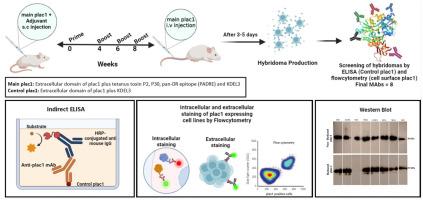Production and characterization of a panel of anti-mouse placenta-specific protein 1 (plac1) monoclonal antibodies
IF 2.6
4区 生物学
Q2 BIOCHEMICAL RESEARCH METHODS
引用次数: 0
Abstract
Placenta-Specific Protein 1 (PLAC1) is essential for normal placental and embryonic development. It is widely expressed in various types of cancer cells. We produced a panel of anti-mouse plac1 monoclonal antibodies (mAbs) with different applications. Two recombinant proteins were produced containing either the extracellular domain (ED) plus tetanus toxin P2, P30, pan-DR epitope (PADRE), and KDEL3 (main plac1) or ED plus KDEL3 (control plac1). Recombinant proteins were used for immunization and screening. Positive clones were selected by ELISA and flow cytometry. Purified mAbs were tested by ELISA, WB, flow cytometry, immunohistochemistry (IHC), and immunofluorescent (IF). A combination of bioinformatics tools was used to predict the target epitope(s) of the mAbs. Eight anti-mouse plac1 mAbs (all IgG1/κ1) were generated, all reacting with high affinity in ELISA. Seven clones recognized plac1 in both reduced and non-reduced Western blots, while one only recognized the non-reduced form. Cross-inhibition ELISA revealed that all mAbs recognized overlapping epitopes with a shared motif except for 5C9. Four clones reacted with the native antigen in flow cytometry, but none were functional in IF or IHC staining. The produced multifunctional mAbs can be used to investigate different aspects of PLAC1 biology in reproduction and cancer.

抗小鼠胎盘特异性蛋白 1(placenta-specific Protein 1,plac1)单克隆抗体的制备与表征。
胎盘特异性蛋白 1(PLAC1)对胎盘和胚胎的正常发育至关重要。它在各种类型的癌细胞中广泛表达。我们制备了一组具有不同用途的抗小鼠胎盘特异性蛋白 1 单克隆抗体(mAbs)。我们制备了两种重组蛋白,分别含有细胞外结构域(ED)和破伤风毒素P2、P30、泛DR表位(PADRE)和KDEL3(主plac1),或ED和KDEL3(对照plac1)。重组蛋白用于免疫和筛选。通过 ELISA 和流式细胞术筛选阳性克隆。纯化的 mAbs 通过 ELISA、WB、流式细胞术、免疫组织化学(IHC)和免疫荧光(IF)进行检测。结合使用生物信息学工具预测了 mAbs 的靶表位。共生成了八种抗小鼠 plac1 mAbs(均为 IgG1/κ1),它们在 ELISA 中均能产生高亲和力反应。七个克隆在还原型和非还原型 Western 印迹中都能识别 plac1,而一个克隆只能识别非还原型。交叉抑制酶联免疫吸附试验(Cross-inhibition ELISA)显示,所有 mAbs 都能识别具有共享基团的重叠表位。四个克隆在流式细胞术中与原生抗原发生反应,但没有一个在 IF 或 IHC 染色中起作用。所制备的多功能 mAbs 可用于研究 PLAC1 在生殖和癌症中的不同生物学特性。
本文章由计算机程序翻译,如有差异,请以英文原文为准。
求助全文
约1分钟内获得全文
求助全文
来源期刊

Analytical biochemistry
生物-分析化学
CiteScore
5.70
自引率
0.00%
发文量
283
审稿时长
44 days
期刊介绍:
The journal''s title Analytical Biochemistry: Methods in the Biological Sciences declares its broad scope: methods for the basic biological sciences that include biochemistry, molecular genetics, cell biology, proteomics, immunology, bioinformatics and wherever the frontiers of research take the field.
The emphasis is on methods from the strictly analytical to the more preparative that would include novel approaches to protein purification as well as improvements in cell and organ culture. The actual techniques are equally inclusive ranging from aptamers to zymology.
The journal has been particularly active in:
-Analytical techniques for biological molecules-
Aptamer selection and utilization-
Biosensors-
Chromatography-
Cloning, sequencing and mutagenesis-
Electrochemical methods-
Electrophoresis-
Enzyme characterization methods-
Immunological approaches-
Mass spectrometry of proteins and nucleic acids-
Metabolomics-
Nano level techniques-
Optical spectroscopy in all its forms.
The journal is reluctant to include most drug and strictly clinical studies as there are more suitable publication platforms for these types of papers.
 求助内容:
求助内容: 应助结果提醒方式:
应助结果提醒方式:


